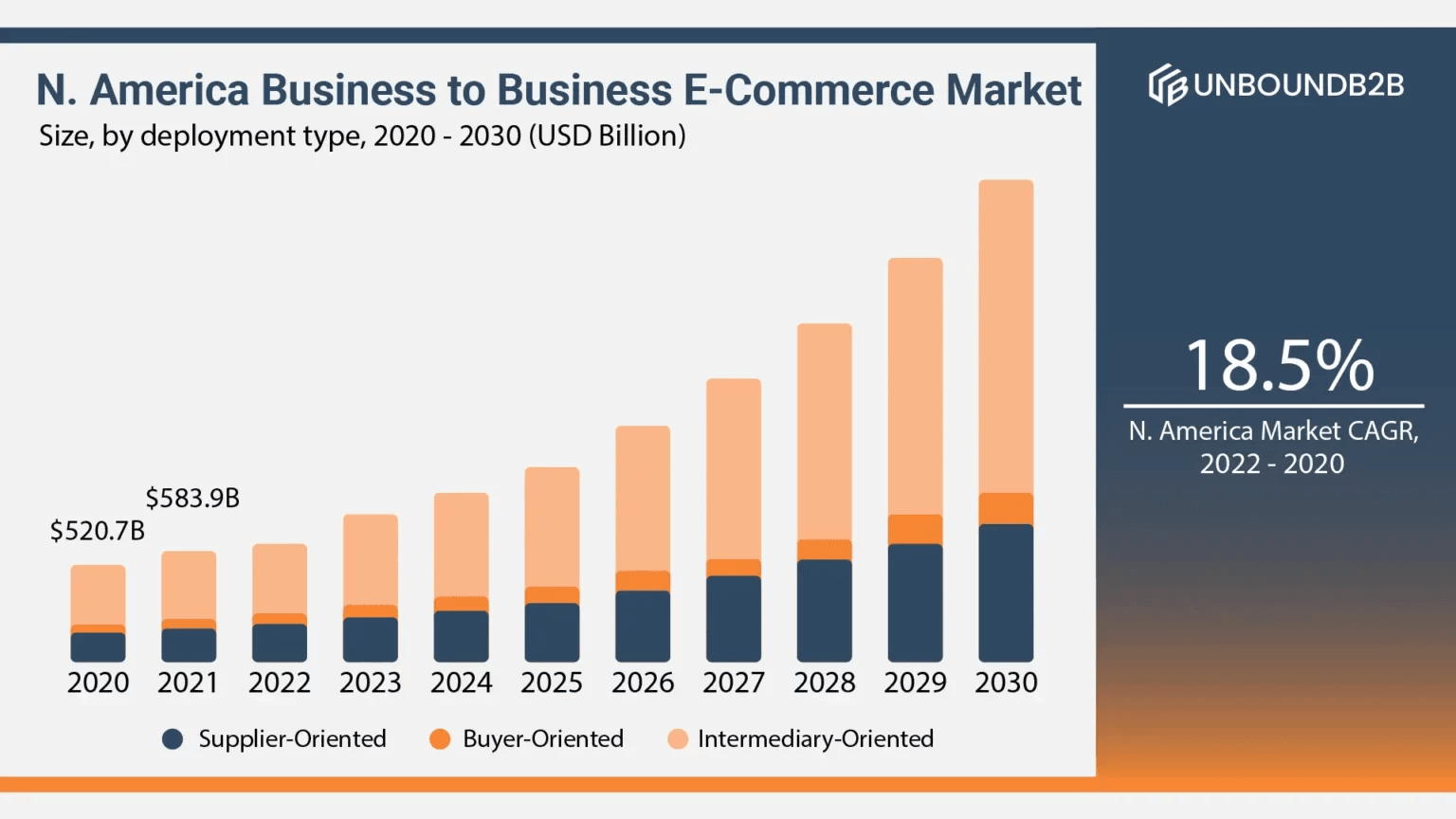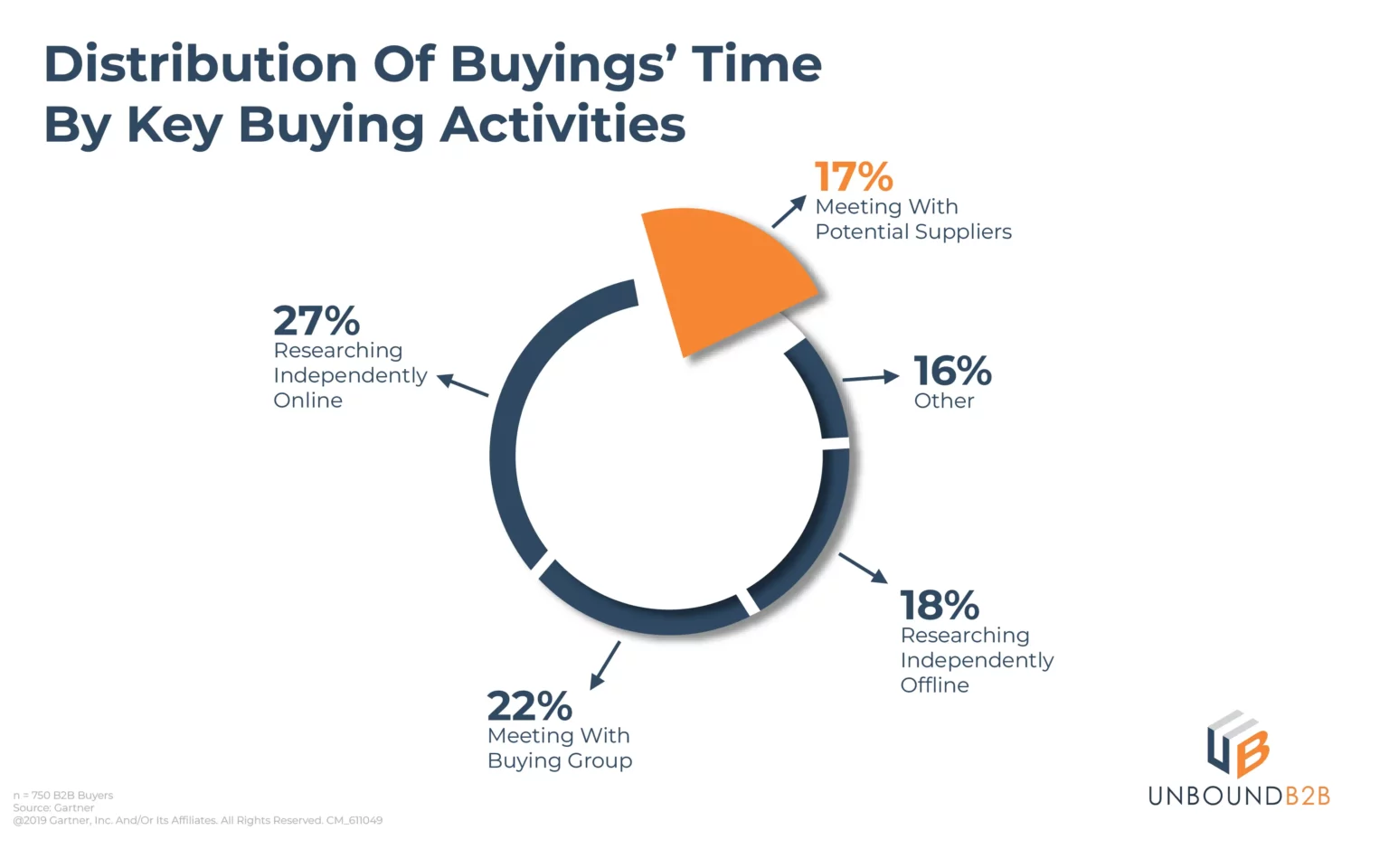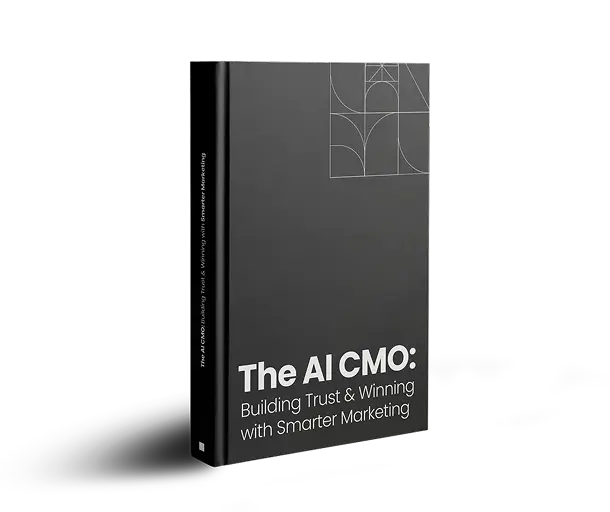
Introduction
The B2B is an enormous industry with a $7907.04 billion reach in 2022, with forecasted revenue of $33,317.37 billion by 2030.

The B2B market is indeed on scavenge. But, one thing that most people peg wrong is—all B2B sales are the same.
Based on your business scale and size, the B2B sales process differs.
For instance, B2B Enterprise and SMB sales leads are different. They have distinctive clientele, needs, operational sizes, and pain points.
Thus, the same marketing strategies, tools, and ideologies are incapable of one another.
Whether you run an enterprise or SMB, you must map out different routes to scale your business.
Don’t know how both B2B sales processes work?
No!
Then, let’s decode enterprise sales vs. SMB sales to better plan your B2B growth strategy.
What are B2B Enterprise Sales?
B2B enterprise sales mean large business contracts involving a full board with higher risks and longer sales cycles.
These sales are million-dollar worth that can impact the GDP of a European nation.
For instance, when a cloud computing giant, Salesforce, acquired Slack for $27.7 billion in July 2021, that was a B2B enterprise sale. It has expanded Slack’s advertisements and brought major changes to both organizations.
What are B2B SMB Sales?
Small and midsize businesses are identified based on the employee base. According to Gartner, organizations with 100 to 999 employees are SMBs.
As a result, B2B SMB sales are less risky and have a short sales process. As a result, these sales are smaller with a few decision-makers.
Now, they aren’t as small as deciding which brand’s paper shredder to order for your office. Instead, it is more on the line, like Semrush acquiring Backlinko.
The deal between both brands was quite closed-lipped, but it is a perfect B2B SMB sale example.
Enterprise Sales vs. SMB Sales: How Both B2B Sales Varies?
There is a misconception that scaled SMBs are enterprises. In reality, enterprises have a founding capital and legal structure quite different from the beginning.
Thus, being a B2B marketer, it is critical to understand the primary comparison between enterprise sales vs. SMB sales. So, let’s explore this comparison point-by-point:
Starting point
Enterprise and SMB sales start at two different points. For instance, the enterprise sales process can begin with rough demos and PowerPoint presentation templates.
In contrast, the SMB sales process should begin once your product has been tested and is ready to accept paying clients without your intervention.
Enterprise sales can begin long before the product is demonstrable or usable by clients. On the other hand, SMB sales begin only when you can show off the product with flair.
Purchase procedure
SMBs and enterprises have utterly different purchasing processes. A small business’s sale process depends on the company’s spontaneous urgent need.
The purchasing journey is frequently an impulsive and unstructured sequence based primarily on the subjective judgment of a single decision-maker.
On the other hand, the enterprise sales process is distinguished by a more organized sequence of actions. It focused more on detailed research of the company’s long-term solutions and the direct involvement of multiple decision-makers. In B2B organizations, an average of 6-10 employees participate in purchasing solutions.
At the same time, only 17% of their time is spent meeting with potential suppliers. The remaining time is spent on offline and online market research, competitor analysis, and internal meetings with other departments.

Buying signals
Enterprise and SMB customers send out different purchase signals. The buying signal is simply a state of ‘progression’ in the Enterprise sales process. First, meetings turn into demos, which turn into technical discussions, discussions with procurement, and then into a purchase order.
Every stage could be a drop-off point in B2B enterprise sales.
The buying signal in the SMB sales process is that the person returned to your site, looked at the pricing page, added someone else to the trial account, began using the product, and so on. Different. Nonetheless, they are similar.
Sales cycle
Small and medium-sized businesses typically have a three-month sales cycle. In contrast, enterprises have a more complex and sophisticated purchase sequence; their sales cycle is much longer, lasting approximately seven months.
Enterprise sales also have much larger budgets, making purchasing more time-consuming. As a general rule, the more money the deal brings, the longer it will take to close.
Aside from that, to win an enterprise contract, a salesperson must deal with approximately thirty objections from all decision-makers, as each of them typically finds four to five pieces of information about your company to clarify before making the purchase.
All of these factors make enterprise selling more demanding and complex.
Key metrics
Enterprises and small business organizations must focus on key performance metrics to measure their sales growth. Here are the important key metrics for enterprise sales:
Total revenue: The average revenue generated for a specific customer ( monthly, quarterly, or annually).
Win rate: The percentage of customers who won as opposed to open, lost, or stagnant opportunities. The win rate is also known as the opportunity-to-win ratio or the opportunity-win rate.
Customer lifetime value (CLV): This estimates how much money a single customer will spend with your company throughout their lifetime.
Lead generation: This is the process of attracting customers to the company to become prospects.
Key performance indicators (KPIs): KPIs are measurements that reflect a company’s or an individual employee’s performance. Typical KPIs include:
- Rates of conversion
- Annual expansion
- Total number of cold calls made
- Total number of sales
Here are some of the key metrics to measure small business growth:
Net profit: It is the amount of money left over after deducting all of your expenses from your total revenue. Net profit includes interest, operating expenses, taxes, and other costs.
Sales growth rate: It is an essential sales and marketing metric that compares total sales for months, years, etc.
Sales velocity: The velocity of your sales pipeline is the rate at which your deals move through it.
Sales pipeline coverage: It is a ratio that compares how full the sales pipeline is at the end of a given period to the quota goal.
Churn rate: The percentage of customers who stop purchasing from your company within a specific time frame. This metric can be calculated by dividing the number of lost customers at the end of the period by the total number of customers at the start.
Expertise level
Sales representatives must develop different skill sets depending on the type of organization they are targeting. For example, the enterprise sales reps must have a certain level of persistence to target multiple decision-makers to maintain close contact with the high-touch approach.
Sales representatives must also have significant experience conducting one-on-one conversations with C-level executives. In addition, they must have enough confidence to address all potential objections. Aside from that, they must gain a thorough understanding of the industry and how the product they sell differs from other competitors on the market.
One of the most important things for sales representatives to remember when dealing with businesses is to focus on building long-term relationships. As a result, their job requires empathy, professionalism, and excellent sales skills.
Things are very different for SMBs. Due to the high sales automation, you can convert leads faster in small business organizations. In addition, the sales pipeline is less complicated and precise in SMBs.
Most SMBs’ goal is to close more deals quickly. As a result, the key qualities SDRs must develop for working with SMBs are the ability to adapt quickly to the conversation, attention to small details, and repeat the same set of actions from one conversation to the next.
Outsourcing operations
Enterprise sales operations are long and confidential. So, enterprises can only outsource some of their sales operations.
But, they can outsource some of their sales operations to competent lead generation organizations like UnboundB2B.
For example, enterprises often contact us to find potential contacts to build an email marketing list or book appointments with prospects.
On the contrary, small businesses can fully outsource their sales operations. They can delegate sales activities to other agencies so their in-house sales department can focus on building client relationships. In addition, we often provide a complete lead gen package to small teams who want to grow on a limited budget.
Pitfalls
The enterprise sales process requires customization, and your product may appear broad but need to be deeper.
Furthermore, every new enterprise will request some customization to add service to the product company. For example, you might need costume accounting software to manage your large employee base and part-time workers to handle new enterprise work.
In an SMB product sales process, that is usually less (or non-existent). The issue with an SMB sale is one of economical. To compensate for one $100,000 Enterprise client, you must sell to 100 clients at $1000 per year.
Sales strategies
By now, you must have understood that sales strategies for enterprises and SMBs differ. Different sales strategies and methodologies can work more effectively in various markets. Here are some suggestions:
SBM’s core network is typically tighter, so it can benefit greatly from referral sales. You must try a more consultative selling approach.
To sell mid-sized businesses, try account mapping to find the right stakeholders and dive deep into case studies of your existing customers to help sell to other similar target buyers.
Target-Account Selling (TAS) is a time-consuming sales strategy that is excellent for tailoring proposals and pitches to potential enterprise customers. It is the perfect sales strategy for enterprises that want to build personal connections with customers to convert prospective deals.
Technical support
Technology is a crucial sales operation factor for both small and large companies. Therefore, the technology stack for enterprises and SMB sales teams is also different.
Enterprises need custom-built solutions that can support their specific business needs. In addition, enterprises have to deal with large amounts of confidential data. So, instead of cloud-based solutions, on-premises IT infrastructure is a more secure option for enterprise sales.
In contrast, SMBs can work with ready-made solutions. For example, a small sales team can get customer relationship software to manage their operations faster.
It is cost-efficient for SMBs as they don’t need to invest in custom IT solutions.
Content messaging
SMBs conduct research the same way consumers do when evaluating a purchase. For example, most SMB decision-makers use Internet searches and review/recommendation websites to make purchase decisions. SMBs also want vendors to explain how their solutions add value to their businesses.
During the purchase process, enterprise customers consult with a variety of experts. Most enterprise decision-makers involved in the buying cycle consult several content materials, such as whitepapers, case studies, webinars, blog articles, and so on.
Enterprise Sales vs. SMB Sales: Which B2B Sales Process Is Better?
It depends on your product. Define your product to understand the difference between enterprise and SMB sales processes and which is better for you.
However, here are a few things to pick the best B2B sales process:
For which process is your organization equipped?
The enterprise sales process is best accomplished through direct sales channels like scheduled calls. That means mid to senior-level salespeople must know how to manage sales cycles and hunt and close deals.
SMB sales processes require the involvement of digital marketers, product specialists, account development executives, sales reps, and others.
The SMB sales process involves making calls, sending emails, and performing the same daily tasks. So, ensure your organization has the right equipment to support your sales process.
Do you have adequate funds?
As you must have guessed, the enterprise sales process is costlier and involves multiple layers. On the top, it takes time to onboard a high-value account.
In contrast, B2B SMB sales processes are less expensive. You can email marketing campaigns at cheaper rates than multi-channel marketing campaigns.
Who are you?
Are you a sales or marketing guy? If you are a digital marketing person, go for the SMB sales process, as it is digital and faster. Otherwise, salespeople can try their luck with the enterprise sales process as they get the right experience and knowledge.
Bottom Line: Enterprise Sales vs. SMB Sales
Finally, we will state that the Enterprise sales process is exhausting. It was mentally and physically exhausting. Speaking from personal experience, it takes a lot to get back up after being slammed with a ‘No’ from an Enterprise that you have been nurturing for 8 months.
The SMB sales process also necessitates focus and rigor – a different kind of exhaustion. But you can do whatever it takes to grow your business.
That’s because some of the best businesses have been built while maintaining both Enterprise and SMB sales with our team. So, let’s connect to find the best B2B sales process for your business.
Our blog
Latest blog posts
Tool and strategies modern teams need to help their companies grow.

Video has emerged as one of the most effective tools to cut through the noise and con...

The way B2B buyers research, engage, and decide has changed and so must the way marke...

Channel marketing helps B2B companies grow by partnering with third-party sellers. It...






